Khadas Mind Premium Review: Raptor Lake-P in a Modular Portable Workstation
by Ganesh T S on September 14, 2023 8:00 AM EST- Posted in
- Systems
- Intel
- Mini-PC
- Raptor Lake-P
- Khadas
Workstation Performance - SPECworkstation 3.1
SFF PCs traditionally do not lend themselves to workstation duties. However, a recent trend towards miniaturized workstations has been observed. Since Khadas markets the Mind as a modular portable workstation, we decided to benchmark the system for both content creation workloads as well as professional applications.
SPECworkstation 3.1
The SPECworkstation 3.1 benchmark measures workstation performance based on a number of professional applications. It includes more than 140 tests based on 30 different workloads that exercise the CPU, graphics, I/O and memory hierarchy. These workloads fall into different categories.
- Media and Entertainment (3D animation, rendering)
- Product Development (CAD/CAM/CAE)
- Life Sciences (medical, molecular)
- Financial Services
- Energy (oil and gas)
- General Operations
- GPU Compute
Individual scores are generated for each test and a composite score for each category is calculated based on a reference machine (HP Z240 tower workstation using an Intel E3-1240 v5 CPU, an AMD Radeon Pro WX3100 GPU, 16GB of DDR4-2133, and a SanDisk 512GB SSD). Official benchmark results generated automatically by the benchmark itself are linked in the table below for the systems being compared.
| SPECworkstation 3.1 Official Results (2K) | |
| Khadas Mind Premium | Run Summary |
| Khadas Mind Premium + Mind Dock | Run Summary |
| ASRock NUC BOX-1260P | Run Summary |
| Intel NUC12WSKi7 (Wall Street Canyon) | Run Summary |
| ASRock NUC BOX-1360P-D5 (Performance) | Run Summary |
| Beelink GTR7 | Run Summary |
| ASRock 4X4 BOX-7735U (Performance) | Run Summary |
| ASRock NUCS BOX-1360P-D4 | Run Summary |
| Intel NUC13ANKi7 (Arena Canyon) | Run Summary |
Details of the tests in each category, as well as an overall comparison of the systems on a per-category basis are presented below.
Media and Entertainment
The Media and Entertainment category comprises of workloads from five distinct applications:
- The Blender workload measures system performance for content creation using the open-source Blender application. Tests include rendering of scenes of varying complexity using the OpenGL and ray-tracing renderers.
- The Handbrake workload uses the open-source Handbrake application to transcode a 4K H.264 file into a H.265 file at 4K and 2K resolutions using the CPU capabilities alone.
- The LuxRender workload benchmarks the LuxCore physically based renderer using LuxMark.
- The Maya workload uses the SPECviewperf 13 maya-05 viewset to replay traces generated using the Autodesk Maya 2017 application for 3D animation.
- The 3ds Max workload uses the SPECviewperf 13 3dsmax-06 viewset to replay traces generated by Autodesk's 3ds Max 2016 using the default Nitrous DX11 driver. The workload represents system usage for 3D modeling tasks.
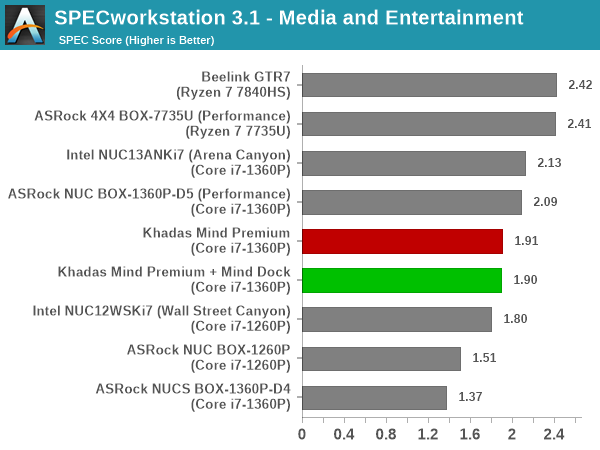
Product Development
The Product Development category comprises of eight distinct workloads:
- The Rodinia (CFD) workload benchmarks a computational fluid dynamics (CFD) algorithm.
- The WPCcfd workload benchmarks another CFD algorithm involving combustion and turbulence modeling.
- The CalculiX workload uses the Calculix finite-element analysis program to model a jet engine turbine's internal temperature.
- The Catia workload uses the catia-05 viewset from SPECviewperf 13 to replay traces generated by Dassault Systemes' CATIA V6 R2012 3D CAD application.
- The Creo workload uses the creo-02 viewset from SPECviewperf 13 to replay traces generated by PTC's Creo, a 3D CAD application.
- The NX workload uses the snx-03 viewset from SPECviewperf 13 to replay traces generated by the Siemens PLM NX 8.0 CAD/CAM/CAE application.
- The Solidworks workload uses the sw-04 viewset from SPECviewperf 13 to replay traces generated by Dassault Systemes' SolidWorks 2013 SP1 CAD/CAE application.
- The Showcase workload uses the showcase-02 viewset from SPECviewperf 13 to replay traces from Autodesk's Showcase 2013 3D visualization and presentation application
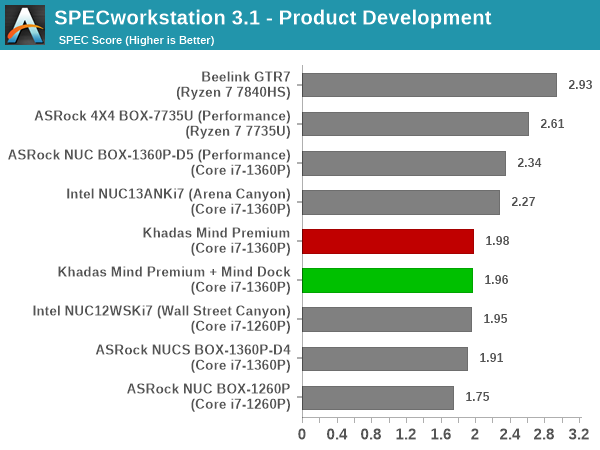
Life Sciences
The Life Sciences category comprises of four distinct test sets:
- The LAMMPS set comprises of five tests simulating different molecular properties using the LAMMPS molecular dynamics simulator.
- The NAMD set comprises of three tests simulating different molecular interactions.
- The Rodinia (Life Sciences) set comprises of four tests - the Heartwall medical imaging algorithm, the Lavamd algorithm for calculation of particle potential and relocation in a 3D space due to mutual forces, the Hotspot algorithm to estimate processor temperature with thermal simulations, and the SRAD anisotropic diffusion algorithm for denoising.
- The Medical workload uses the medical-02 viewset from SPECviewperf 13 to determine system performance for the Tuvok rendering core in the ImageVis3D volume visualization program.

Financial Services
The Financial Services workload set benchmarks the system for three popular algorithms used in the financial services industry - the Monte Carlo probability simulation for risk assessment and forecast modeling, the Black-Scholes pricing model, and the Binomial Options pricing model.
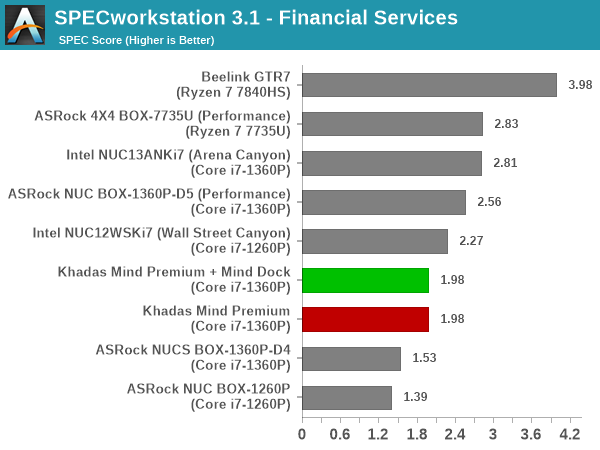
Energy
The Energy category comprises of workloads simulating various algorithms used in the oil and gas industry:
- The FFTW workload computes discrete Fourier transforms of large matrices.
- The Convolution workload computes the convolution of a random 100x100 filter on a 400 megapixel image.
- The SRMP workload processes the Surface-Related Multiples Prediction algorithm used in seismic data processing.
- The Kirchhoff Migration workload processes an algorithm to calculate the back propogation of a seismic wavefield.
- The Poisson workload takes advantage of the OpenMP multi-processing framework to solve the Poisson's equation.
- The Energy workload uses the energy-02 viewset from SPECviewperf 13 to determine system performance for the open-source OPendTec seismic visualization application.

General Operations
In the General Options category, the focus is on workloads from widely used applications in the workstation market:
- The 7zip workload represents compression and decompression operations using the open-source 7zip file archiver program.
- The Python workload benchmarks math operations using the numpy and scipy libraries along with other Python features.
- The Octave workload performs math operations using the Octave programming language used in scientific computing.
- The Storage workload evaluates the performance of the underlying storage device using transaction traces from multiple workstation applications.
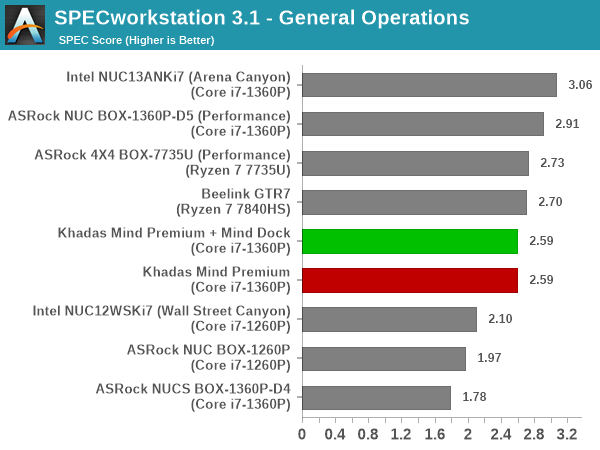
GPU Compute
In the GPU Compute category, the focus is on workloads taking advantage of the GPU compute capabilities using either OpenCL or CUDA, as applicable:
- The LuxRender benchmark is the same as the one seen in the media and entertainment category.
- The Caffe benchmark measures the performance of the Caffe deep-learning framework.
- The Folding@Home benchmark measures the performance of the system for distributed computing workloads focused on tasks such as protein folding and drug design.
We only process the OpenCL variants of the benchmark, as the CUDA version doesn't process correctly with default driver installs.
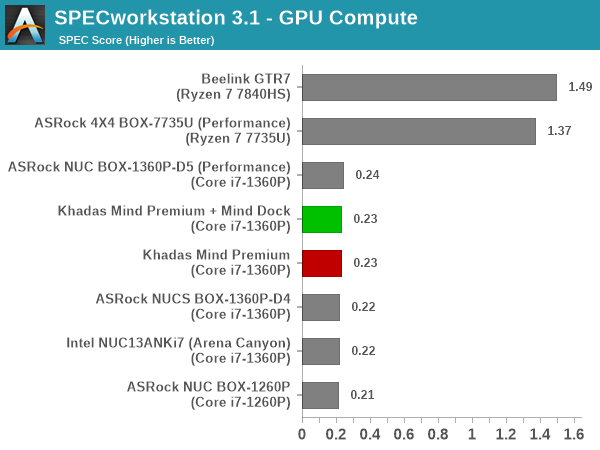
Most of the Ryzen-based systems are equipped with a large number of high-performance cores. This translates to better performance for select workloads compared to what is obtained using the hybrid scheme of performance and efficiency cores from Intel. Within the set of systems with similar number of cores, if the generation-to-generation improvements (RPL-P being better than ADL-P) are discounted, we find that the performance is essentially dependent on the available power budget. The main exception is GPU Compute - a weak point for Intel's iGPUs, as they can't complete some of the components successfully. The net result is that the Mind Premium configurations land up in the middle of the graph across all of the SPECworkstation 3.1 components.










20 Comments
View All Comments
wr3zzz - Thursday, September 14, 2023 - link
This is what Intel NUC should've been. 450 grams, sleek look, magnetic snap-on interface for compatible docking station, e-GPU, portable and fixed displays.hubick - Thursday, September 14, 2023 - link
Thunderbolt eGPU's and stuff are already niche enough, and being invested in that ecosystem, the proprietary connector is a deal breaker for me. I fully lost interest when I saw the RAM was soldered. It's a shame they went proprietary, cuz this looks neat.meacupla - Thursday, September 14, 2023 - link
It has 32GB of LPDDR5 5200. How much more do you want?Samus - Friday, September 15, 2023 - link
Seriously, and there aren't really any options out there for high speed low profile memory. I'd take soldered LPDDR5 over any regular DDR4\5 socket, just make sure you get 16GB-32GB depending on your future use case. Nobody is going to keep running this thing 10 years from now when 32GB won't suffice.Meanwhile most PC's ship with 16GB and I still see 8GB in laptops, which has been pretty standard for...10 years.
PeachNCream - Thursday, September 14, 2023 - link
This was absolutely sent to Future for the free advertising that an article about it would generate AND it's a pretty stupid idea since, well laptop and desktop workstations both exist and offer either more flexibility and the same relative compute power (typically with a larger company's backing) OR more compute power for the same cost. The gimmicky form factor is only a gimmick and nothing more.ganeshts - Thursday, September 14, 2023 - link
'Product sent for free advertising' - The way PR works is that the agency is tasked with promoting product awareness. 'Advertising' - at least in the TV / Internet age - refers to something that focuses purely on the positives of a product and pushes viewers / readers to go out and purchase the product. It is always a good idea to approach any article or review with wariness, but it looks like you want to see malice where there is none.PR agencies and reps pitch countless products for review, and we don't have enough resources or man-hours to justify an AnandTech-level review for each of those pitched products. Personally, I take up a product for review only if it offers something new or novel. There is absolutely no doubt that the Mind Family of products is something that has not been attempted successfully before. It may appear gimmicky, but the engineering effort towards creating a 256 Gbps external peripheral interface is definitely not something to be viewed with derision (which is what your post comes across as).
Every time a company tries to create something new with focus on multiple product categories - 'a jack of all trades', there is always going to be a 'master of one' competitor. The question is whether the new product can evolve over multiple generations to re-frame the paradigm. (I would take the example of an iPod that appeared when there were other MP3 players in the market too. In fact, other than branding and industrial design, it wasn't offering too much novelty. But, that slowly metamorphosed into the iPhone juggernaut over a 15 - 20 year timeframe).
The reason I am typing out this lengthy response is not because I have a vested interest in promoting the Mind family. In fact, you can see we do not even carry a link to the crowdfunding site where Khadas is currently selling the system before moving it to the Khadas shop / Amazon. Rather, I want to make sure readers are able to see the big picture as well as detailed specifics on where Khadas should be improving. I would say that in the last 5 - 7 years, this mini-PC is probably the one that I have spent the most time in reviewing - just because it is very different from what is usually put out in this space. And, I would love readers to understand that.
Coming back to the 'advertising' claims - did you even read the concluding section? Khadas actually links to various reviews from their crowfunding campaign. I suspect it is unlikely they are going to link to our review. We have always aimed to present a balanced view of products and its capabilities. As it stands today, Khadas still has much to prove. That said, there is plenty of potential and the Mind Link interface is certainly praiseworthy for its capabilities (it is better than external OCuLink and Thunderbolt 5 from a technical viewpoint).
meacupla - Thursday, September 14, 2023 - link
When do you expect to see the GPU and monitor docks become available?When they do, are you going to review those?
ganeshts - Friday, September 15, 2023 - link
The GPU should be available in June 2024. There is no ETA yet for the other peripherals.As for review, it depends on Khadas. If they offer, I will definitely take it up [ as we do have a concrete idea of how eGPU enclosures need to be evaluated - https://www.anandtech.com/show/13944 ]
meacupla - Friday, September 15, 2023 - link
oof, that is a rough launch window for the GPU dock. They should have stuck to an already established connector, like occulink.Samus - Friday, September 15, 2023 - link
Probably not worth considering the i7-1360P. It is (in real world performance) virtually identical to the i5-1340P.I have two notebooks with an i5-1240P and i7-1260P respectively and you literally would never be able to tell them apart in any task. The only difference as far as I can tell is slightly higher base and boost clock, and the i7 has more L3 cache that doesn't seem to mean anything in most applications. The GPU core has an additional core (so 96 EU's over 80 EU's in the i5.) They are otherwise identical CPU's with the same P and E cores.